Department of Hydrobiology of the University of Debrecen has measured the current state of fish fauna of the Nagykunság Main Channel near sluice of Lake Tisza (coordinates: N47.4502, E 20.5517) at the request of the Federation of Anglers Associations of Lake Tisza. The sampling was performed from boat with electrofishing gear in a 300 meter long section. 1020 specimens of 16 fish species were identified (Table 1.).
| Species | Number of specimens (N) | Dominance (%) |
| Rutilus rutilus - Roach | 19 | 1.86 |
| Scardinius erythrophthalmus - Rudd | 20 | 1.96 |
| Leuciscus idus - Ide | 1 | 0.10 |
| Leuciscus aspius - Asp | 9 | 0.88 | Alburnus alburnus - Bleak | 857 | 84.02 |
| Blicca bjoerkna - White bream | 30 | 2.94 | Abramis brama - Bream | 45 | 4.41 |
| Tinca tinca - Tench | 1 | 0.10 |
| Rhodeus amarus - Bitterling | 4 | 0.39 |
| Carassius gibelio - Prussian carp | 7 | 0.69 | Ameirus melas - Black bullhead | 14 | 1.37 |
| Esox lucius - Pike | 2 | 0.20 |
| Lepomis gibbosus - Pumpkinseed | 6 | 0.59 |
| Sander lucioperca - Pikeperch | 1 | 0.10 | Sander volgensis - Volga pikeperch | 1 | 0.10 |
| Proterorhinus semilunaris - Tubenosed goby | 3 | 0.29 |
Our results suggest that the fish fauna of the upper section of the Nagykunság Main Channel is rich and contains the more popular game fish species. Species composition is similar to Lake Tisza, because the Channel’s water and fish population are mostly from the dammed reservoir. High abundance of bleak is favorable mainly for our pelagic predatory fish species the asp. Outstanding that in this study offspring of bitterling was found. Moreover, 12 of the 16 species and 990 of the 1020 specimens (97%) were been native, adventive species were rarely found.
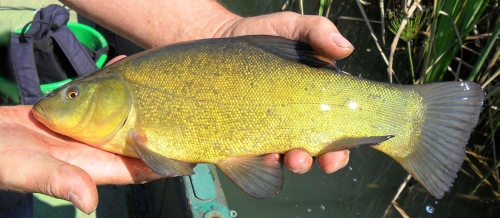
Large tench from the Nagykunság Main Channel (Photo by József Molnár)
In summary, the Nagykunság Main Channel artificially created for irrigation, is not only popular fishing water, but also an ecologically important fish habitat.
Krisztián Nyeste, Dalma Dobronoki, József Molnár
Citation: Nyeste K., Dobronoki D., Molnár J. (2017): A Nagykunsági-főcsatorna kezdeti szakaszának halai. Halászat 110/1: 14.
On the initiative of the Hungarian Ichthyological Society the Department of Angling and Fisheries Management of the Ministry of Agriculture, the Hungarian National Angling Federation, the Organization of Aquaculture and Fisheries Producers, as well as the Hungarian Aquarists' Association have taken a collective decision to celebrate Fishes' Day every 20th March beginning with 2017.
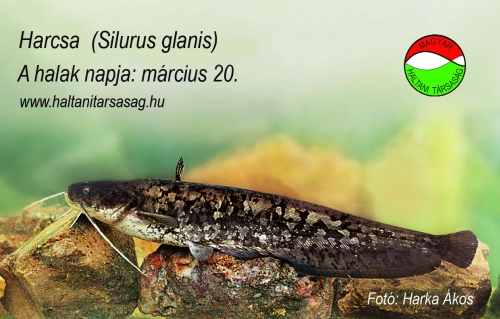
The primary aim of the illustrious day is the further popularization of fishes as in our opinion they actually don't get the well-deserved attention from the society that would meet their importance. The central event of the Fishes' Day will be a conference to be held in the headquarters of the Hungarian National Angling Federation on 20th March where invited lecturers will speak on the importance of fishes and actions for their popularization in the presence of representatives of the press.
Following the introduction of Chinese carps to Hungary there was a general opinion that these fish species cannot successfully reproduce themselves in natural conditions of our country. However from the 1970-ies occasionally juveniles of silver carp appeared in such quantities in the water system of the Tisza that could be explained only by the fact of natural spawning. In July 2008 Harka and his colleagues observed silver carp juveniles of under 20 mm body length in a bay of the Lake Tisza where they could not been drifted from outside. According to them this related to the possibility of spawning in stagnant water.

Juveniles of silver carp in Tiszavalk Pool (photo by Gábor Papp)
On 7th July 2016 we observed unusual groups of juvenile fish near the shoreline in the Tiszavalk basin. We could catch 9 specimens of these fish identified as silver carps. We preserved these fish in a formalin solution of 5 %. The body length of silver carp juveniles that time varied between 19-21 mm.
In the next week we caught about 500 specimens in the same spot by the help of a SAMUS 725 PM electro fishing equipment. As silver carp juveniles have not find as far in other basins of Lake Tisza it seems possible that the spawning took place in the area of the Tiszavalk basin. Nevertheless the possibility of spawning also in other areas of the reservoir or in the Tisza River cannot be excluded.
According to our knowledge silver carp breeds in a water temperature of 23-24 °C, it means the warming up of the waters create favorable conditions for the reproduction of silver carp. In the near future the Tisza-Lake Sportfishing Nonprofit Company is planning to increase its efforts in the selective fishing of the silver carp stock.
Gábor Nagy, Gábor Papp
Citation: Nagy G., Papp G. (2016): Busaszaporulat a Tisza-tavon. Halászat 109/3: 17.
Fish faunal investigations at October 2015 were provide new localities of european mudminnow (Umbra krameri), rotan (Perccottus glenii) and spiny-cheek crayfish (Orconectes limosus) in area of Béda-Karapancsa landscape protection area and Kalocsai-Sárköz. We found three individuals of european mudminnow in Füzeséri-Holt-Duna (coordinates: N46.05870 E18.83887). One specimen were captured in the Canal Sárközi I. (Vajas-fok) near Miske (coordinates: N46.44182 E19.00600), and were caught two european mudminnow individuals from Canal Maloméri (coordinates: N46.50924 E19.05240).

Amur sleeper from the Canal Sárközi I. (photo by Péter Takács)
At both two sampling sites of Canal Sárközi I. (coordinates: N46.44182 E19.00600; N46.39510 E18.95224) were found six rotan individuals, and four specimens in Canal Maloméri (coordinates: N46.50924 E19.05240). During fish faunal investigations we found spiny-cheek crayfish individuals at both sampling sites of Canal Sárközi I. and Canal Csorna-Foktői (coordinates: N46.52684 E18.93110).

One of the collected spiny-cheek crayfish specimens (photo by Péter Takács)
We can notice the spread of rotan and spiny-cheek crayfish within Kalocsai-Sárköz area. However, this invasive species has not still proved in Béda-Karapancsa landscape protection area, their presence can be presumable due to the contiguity with Kalocsai-Sárköz.
Zoltán Vitál, Péter Takács
Citation: Vitál Z., Takács P. (2016): A lápi póc (Umbra krameri), az amurgéb (Perccottus glenii) és a cifrarák (Orconectes limosus) előfordulásának újabb adatai Dél-Magyarországról. Halászat 109/3: 16.
The pearl roach, a species of restricted geographic range, first described by Heckel in 1851 is one of the endangered fish species in Europe. Its relatively significant stocks survived only in three Austrian alpine lakes and there is a smaller population living in the Austrian reach of the Danube. Migrating or washed off representatives of the latter may also appear in the Slovakian and Hungarian part of the river however it happens very rarely. The first and as far the only one Slovakian specimen – deposited in the collection of the National Museum in Bratislava – had been caught at Radvan nad Dunajom in 1975. On this basis we could be sure of its incidental occurrence also on the territory of Hungary but the evidence was keeping us waiting for a long time. Though in the northern part of Budapest in the period of 1992-1994 in the catch of an angler there was a fish that looked like a pearl roach but no detailed examination took place so the specimen of evidence was found a few years later, in autumn of 1998 from the Danube at Dunakiliti.
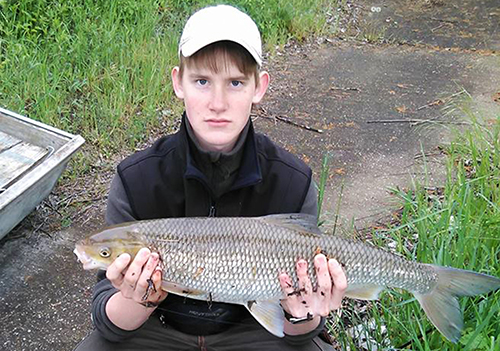
Gábor Szalai with the pearl roach caught by him (photo by Szabolcs Szekeres)
For a period of eighteen years that has been the only one documented data on the occurrence of the species in Hungary but owing to a tenth class schoolboy the occurrence has been confirmed. Gábor Szalai, resident of Dunakiliti angling on the headwater of the dam constructed on the confines of the village on 2nd May 2016 caught a fish that at once seemed to be a rarity. Fortunately ha was in the company of his friend who took two photos by the help of a mobilphone before releasing the fish to the Danube. These photos were sent by e-mail to the address of the Hungarian Ichthyological Society requesting help in identification of the fish species. After examination of the photos by different experts it was the uniform view that the fish is a pearl roach (Rutilus meidingeri). At the same time it was repeatedly proved that the service started on the website of the Society in 2012 helping to identify the fish in the catch is useful not only for anglers but it can also supply data for researchers on the occurrence and frequency of our fish species.
Ákos Harka
Citation: Á. Harka (2016): A gyöngyös koncér (Rutilus meidingeri) második bizonyító példánya Magyarországról. Halászat 109/2: 13.
In 2012 we observed mass proliferation of our smallest fish, the Caucasian dwarf goby in the Tiszafüred basin of the Tisa Lake reservoir. This small fish attaining a length of 3 cms at mostis not markedly good swimmer however downstream it spreads rapidly. Due to current of the river it reached Csongrád in 2014 then in 2015 Senta in the Vojvodinan section of the Tisa. Differently, it moves on clumsily against the current, so int he autumn of 2014 we did not observed yet in the Tisa reach above the reservoir nor in the lower tributaries. Although in 2015 it was found in the Körös section at Mezőtúr but additional ivestigations had showed that the fish migrated there not from the mouth of the river but from the Hortobágy-Berettyó flowing into the Körös in the vicinity.
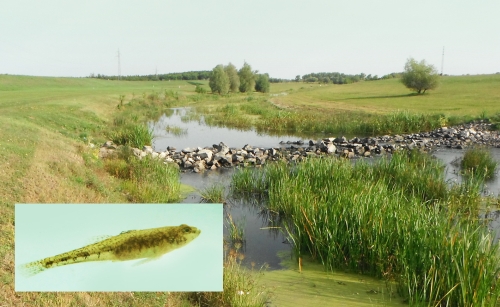
Dwarf goby from the Zagyva section above Szolnok (Photos by Ákos Harka)
During high floods the Tisa dams up the lowest reaches of the tributaries where the water may become stagnant or even its current may change to the opposite. Such a situation occured also at Szonok in the spring of 2015 helping the dwarf gobies present already in great number in the to find entrance to the tributary. Probably owing to this by the help of handseine of 6 mm meshsize we caught a specimen of the Caucasian dwarf goby (Knipowitschia caucasica) 3 kms from the mouth in a stagnant water inlet of the Zagyva (geo-coordinates: 47.198513, 20.203531). Thick vegetation and slow current of the near-mouth reach create favourable conditions for the new-comer species so we can expect its proliferation in the near future.
Zsolt Szepesi, Ákos Harka
Citation: Szepesi Zs., Harka Á. (2016): Megjelent a törpegéb (Knipowitschia caucasica) a Zagyva szolnoki szakaszán. Halászat 109/1: 15.
A team consisting by far the greatest number of Hungarian researchers identified a fish species new to science in the Körös (Crisul) watersystem. The research program resulting in a new barbel species was headed by Dr. László Antal, assistant professor in the Department of Hydrobiology of the University of Debrecen, secretary of the Hungarian Ichthyological Society. The new species got the name Biharian barbel (Barbus biharicus) to indicate the region where it has developed; the authors of the description are: László ANTAL, Brigitta LÁSZLÓ and Petr KOTLÍK.
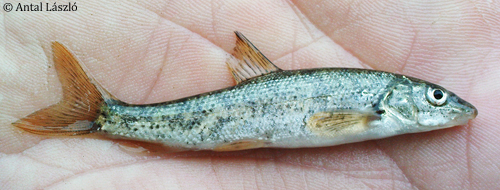

Biharian barbels from Sebes-Körös River
It has been known by the ichthylogists that in addition to the barbel (Barbus barbus) popular among anglers there has been also living in the Körös watersystem an other, smaller barbel species but it has been considered spotted (or Petényi's) barbel (Barbus petenyi) for one and a half century. During careful investigation of the Hungarian population it was discovered that in the Körös watersystem a new species is native that as far has not been known in the science. Due to the finding of the research team not only our ichthyological knowledge has been increased but also our natural heritage has been enriched with an additional autochtonous species of Carpathian basin.
Ákos Harka
During our fish faunistical surveys we systematically collect samples in the section of the Zagyva River in Szolnok County. In such an occasion on 18th September 2014 we found in our net two specimens of the mosquitofish (Gambusia halbrooki) near the railway bridge. One year later, on 4th September 2015 we caught 10 more specimens in the same 200 meters long river section. These fish belonged to three size-categories, so it became evident that the largest ones were not borne in this year but they were overwintered specimens.

Mosquitofish from the Zagyva section in Szolnok (Photo: Ákos Harka)
According to the literature the mosquitofish is a warmwater-loving species however it can tolerate the temperature changes between relatively wide limits of 0-30 °C. In Hungary as far its selfsustaining populations have been developed only in thermal waters. In spite of the fact that in the region of Szolnok there is no higher temperature water outlet to the Zagyva River, the mild winter of 2014/2015 created possibilities for survival of the fish of unknown origin. Further survival of the population is unsure for the time being but due to climate change we can expect the development of selfsustaining populations of the species also in waters of normal temperature.
Zsolt Szepesi, Ákos Harka
Citation: Szepesi Zs., Harka Á. (2015): Szúnyogirtó fogaspontyok (Gambusia holbrooki) megtelepedése a Zagyvában. Halászat 108/4: 11.
The new fish-pass at Kisköre barrage that provides migration route of fish in the middle section of the Tisza has started its operation on 28 October 2015. The monitoring of the 1371 m long canal in 2015 a total of four times is carried on in early spring, late spring, summer and autumn aspects. As a result of three sampling period can be concluded that the fishes have occupied the new habitat, the migration can be observed both to up- and downstream direction. The number of registered fish species in the fish-pass is 32 until this time.
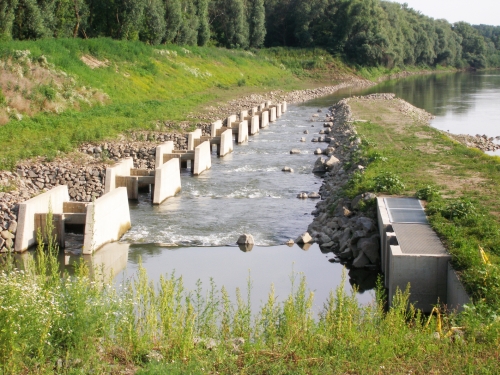
The lower section of the fish-pass at Kisköre; the locality of the newly occured spirlin (Photo: Béla Halasi-Kovács)
During the monitoring survey a new species, the spirlin (Alburnoides bipunctatus) that was unknown from this section of the river earlier has occurred. The two specimens caught from the lower part of the canal were identified as 1+ age, based on their length. The occurrence of this protected species in this section of the river, provide a new evidence of the expansion of the spirlin in the Danube basin.
Béla Halasi-Kovács, Vilmos Józsa, Károly Györe
Citation: Halasi-Kovács B., Józsa V., Györe K. (2015): Sujtásos küsz - Alburnoides bipunctatus (Bloch, 1782) - a Tisza középső szakaszán. Halászat 108/4: 11.
Following a rather stable low-water period at last a smaller inundation of the Mura made it possible to range over the reach between Alsószemenye and Murarátka by motorboat on 23rd April 2015. We were collecting fish faunistic data - collaborating with András Lelkes, Kornél Meilinger and Szabina Hári of the Directorate of the Balaton Uplands National Park - by the help of a SAMUS 724 type accumulator drived electric research fishing equipment partly on the shoreline stones, partly in two shoaly sections of the Mura River.

Evidentiary and released specimen of bullhead (Photo: Csaba Megyer)
At Murarátka near the shoreline stones besides the common species as bleak (Alburnus alburnus), schneider (Alburnoides bipunctatus), asp (Aspius aspius), chub (Leuciscus cephalus) and burbot (Lota lota) we also found a brown trout (Salmo trutta m. fario). In a few minutes however we had forgotten it because we succeeded to take out a specimen of the bullhead (Cottus gobio) from among the stones. Its turning up has been a real sensation as the species hasn't been known from the Hungarian reach of the Mura.
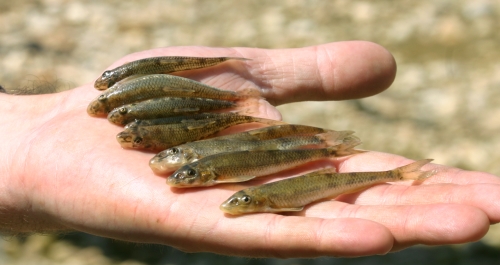
9 specimens of the Danubian gudgeon: a total nature-protection value of 900,000 HUF (Photo: Csaba Megyer)
Going further on in a gravelly section of one meter depth near the shoal we caught bream (Abramis brama) and bitterling (Rhodeus amarus) as well as large numbers of chub and barbel (Barbus barbus). At the shallow, 10-30 cm edge of the shoal young specimens of barbel and nase (Chondrostoma nasus) were observed en masse. It was very joyful that at the upper part of the shoal adult specimens of the strictly protected Danubian gudgeon (Romanogobio uranoscopus) were found in much higher number than the representatives of the gudgeon (Gobio gobio).
Megyer Csaba
Citation: Megyer Cs. (2015): Botos kölönte (Cottus gobio) a Murából. Halászat 108/4: 12.
The first schneider from the Rákos Creek had been caught in the Rákoskeresztúr reach on 1st January 2014 as it was communicated by a local resident Bencze Bodor. During a later faunistic survey on 12th August 2015 I also caught a specimen of this species about 100 m downwards from the spot of the first catch (geocordinates of the locality: N 47.488722, E 19.229588).

Schneider caught in the Rákos Creek (Photo: Balázs Szendőfi)
In this concrete bed reach of the creek that is rather far from its mouth the reophil species (gudgeon, fingerlings of nase, chub etc) proved to be frequent in the last decade. The appearance of the protected schneider characteristic of the waters of hilly and mountainy districts grants a higher nature-protection value for this watercourse that was heavily polluted and a result fishless during decades but has been purified and recovered in the last few years.
Balázs Szendőfi
Citation: Szendőfi B. (2015): Sujtásos küsz (Alburnoides bipunctatus) a budapesti Rákos-patakban. Halászat 108/4: 12.
In connnection with the 20th August celebrations of Saint Stephen' Day and the foundation of Hungary many outstanding representatives of different disciplines were awarded with state honours, among them also the chairman and the vice-chairman of our Society. Both of them were awarded by the president of the Republic Dr. János Áder with the Hungarian Golden Cross of Merit.
Dr. Ákos Harka took over the medal and its certification during the celebration hold int the Vajdahunyad Castle on 19th August 2015 from the minister of agriculture Dr. Sándor Fazekas for the outstanding achievements of research works on the fish fauna of the Carpathian Basin, as well as for the popularization of the waters and the fishes of our country.

Dr. Lajos Juhász in the Vigadó Concert Hall also on 19th August received the decoration from the minister for human resources Mr. Zoltán Balog for outstanding scientific results at both national and international level and as an appreciation of his considerable activities for the development of education.
Congratulations for both of them and wishes of further successes!
László Antal
Citation: Antal L. (2015): A Magyar Haltani Társaság vezetőinek állami kitüntetése. Halászat 108/3: 13.
An adult female specimen of Knipowitschia caucasica was caught in the Hármas-Körös at Mezőtúr on 16 May 2015. The sampling site (E20.557531° N46.915481°), which is located upstream of the Békésszentandrás dam is typical lenitic habitat, with muddy bottom, roots of terrestrial plants, and rare waterweeds.
For species migration route detection, additional targeted surveys were carried out in the River Hortobágy-Berettyó leading into the Hármas-Körös, also in the Hármas-Körös at the upper section of the mouth of River Hortobágy-Berettyó. Sampling sites in Hortobágy-Berettyó were at Túrkeve (E20.761507° N47.082480°) and south to Mezőtúr (E20.635539° N46.982751°). The locations in the Hármas-Körös were at the mouth of the drainage channel of Peresi-Holt-Körös (E20.669011° N46.942340°) and near Gyomaendrőd.
The species was observed in both of the two sampling sites of Hortobágy-Berettyó and in the channel of Peresi-Holt-Körös that is also connected to River Hortobágy-Berettyó, while could not been detected in the upper site of Hármas-Körös (It is marked with empty circle on the figure).

Occurrence of Knipowitschia caucasica in the Körös river-system
Based on the recent data, the most presumable explanation of the origin and the spread of the Knipowitschia caucasica in the Carpathian Basin can be summarized as follows. (1) The species had been appeared by accidental introduction in the Carpathian Basin. (2) Genetic origin of the Carpathian Basin population can be the northern Black Sea coast. (3) Spreading the species is spontaneous in the Tisza river-system. (4) The spread is clearly shows for the upper sections towards the direction of the lower ones both the Tisza and its tributaries and canals. (5) The downward migration is very fast, while in contrast, the upward spread of extremely slow. (6) Further rapid spread of the smallest Hungarian fish species is predictable in the Tisza river-system.
Béla Halasi-Kovács, Zsolt Szepesi, Ákos Harka
Citation: Halasi-Kovács B., Szepesi Zs., Harka Á.: (2015): Kaukázusi törpegéb (Knipowitschia caucasica) a Körös vízrendszerében. Halászat 108/3: 13-14.
During 2013 and 2014 we carried out a series of ichthyological surveys along the upper Maros/Mures Gorge without capturing huchens. Based on information provided by local anglers and a recent publication (Cengher 2007), we were aware of the fact that huchens were present in the gorge. The question was as to whether the population was able to reproduce under natural conditions or only the specimens originating from artificial stocking survived.
The answer came in November 2014 when - together with Ferenc Alpár Gothárd, Levente Farkas,István Adorjáni, Zsolt Györfi, Zoltán Nagy and Sándor Mátyás Bíró - we made a survey of the huchen population. On that occasion, beyond two, 57 and 59 cm long, huchen specimens (of approx. 2 kg) also a juvenile individual of 23 cm in length was caught. According to our information the last stocking took place in 2003 and in our opinion it is evident that the juvenile individual comes from natural reproduction. In addition to the above specimens, a huchen of a length of 96 cm weighing 7 kg also was caught (photo). Of course, all fish were released to their natural habitat.

The most beautiful huchen of the our survey (Photo: Ferenc Alpár Gothárd)
In 2014 anglers provided additional information about the capture of two huchens (a photo was attached in both cases). According to these, the huchen is present in the Maros/Mures River down to Marosvásárhely/Târgu Mures city and we can say that at present, a spawning, but very fragile population lives on the upper course of the Maros/Mures River. The latter, rather pessimistic assumption is based on several factors. One of these is the fact that despite repeated stockings in this section of the Maros/Mures River in the past half-century, huchens were apparently only recently able to form a self-sustaining population here. Poaching continuously decimates the huchen population, which is also affected by water pollution. Devastating flood protection works are planned for the near future. Logging is still common and the construction of micro hydropower plants are planned. In addition, the dam built on the Ratosnya/Răstolita River in order to collect water from Ilva, Galonya/Gălăoaia and Bisztra/Bistra rivers will be put in function, thus optimal reproduction sites of the huchens will be significantly reduced.
In order to protect the huchen population, the immediate elimination of poaching is needed, wich can be achieved with frequent controls. Such actions need to be especially frequent in the reproduction period, when huchens migrate to their spawning sites in the affluent rivulets (Ratosnya/Răstolita, Szalárd/Sălard and Ilva) where they become easy prey for poachers. However, the long term survival of the huchen population also calls for landscape scale changes. These include the building of a functioning wastewater network and the implementation of sustainable forestry, which would result in the reduction of pollutant leaching in the natural waters.
András Attila Nagy, István Imecs
Citation: Nagy A. A., Imecs I.: (2015): A felső Maros-szoros galócái (Hucho hucho). Halászat 108/3: 14.
Information on an interesting catch has been reported from the Danube stretch near Ács. On 17th April 2015 a Danube roach of considerable size took the hook of the angler Csaba Porpáczy (resident of Tata). Standard length of the fish was 51 cm while its estimated weight was cca. 3 kgs. As the angler did not want to torment the representative of a protected species, following a quick measurement of the body-length and taking some photos, he put back the fish into the natural habitat. Unfortunately there were no digital scales at the spot as the length and the estimated weight of the fish could be probably very to the data of the leader of the Hungarian anglers' record list of the species, in spite of the fact that it was a female already after spawning. The actual record specimen is of 52 cm and 3.21 kgs.

Portrait of the Danube roach caught at Ács (Photo: Csaba Porpáczy)
The Danube roach is a high value inhabitant of our waters being an endemic species living only int he Danube and its tributaries. According to the actual law it is in the category of protected species with a nature protection value of 10,000 HUF. The majority of the endemic species is in the category of strictly protected species that might justify the requlifying of the Danube roach in the future.
Tivadar Kontos
Citation: Kontos T.: (2015): Rekordközeli leánykoncér (Rutilus virgo) a Dunából. Halászat 108/3: 15.
As a result of water regulation in the 19-20. century (especially at River Olt the former floodplain has disappeared in the Transylvanian basin of Ciuc (Harghita county), and the natural environment has greatly changed in the same time. Most of the marshes and wetlands were drained, therefore mass occurance of fish species (crucian carp, weatherfish) became rarefied. ACCENT GeoEcological Organization (Tusnádfürdő) has won a project to preserve the good condition of certain habitats at Natura 2000 area of Lower Ciuc basin, and one element of the work is to help the indigenous weatherfish population. Department of Aquaculture of Szent István University provides technical assistance during the work.
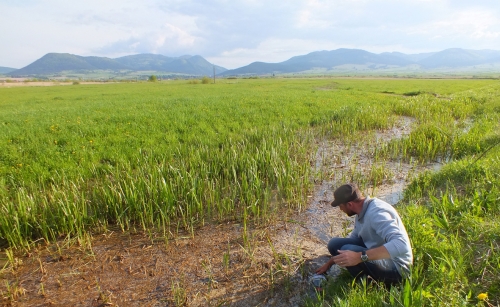
Introduction of weatherfish in Ciuc basin (Photo: István Imecs)
First step was to reconstruct an old river channel, the former home of river Olt, but it was filled, so it almost disappeared. The river bed is 700 m long and water surface is almost 1 hectar so it is suitable habitat for a weatherfish population. Second step is induced propagation. Eight female and three male weatherfish were caught directly before hatching and after induced propagation process 60000 eggs were stripped (5/5/2015) with a fertilisation rate more than 90% after 48h. Almost 10000 feeding larvae were introduced to the adequate habitat which is the first weatherfish introduction in Harghita. In the future, we are going to build systems that will be suitable for rearing weatherfish larvae and juveniles.
For us, not just the nature conservation value of the fish is important (weatherfish can be found on the logo of Lower Ciuc Basin Natura 2000 area), but the etymology of the place's role also contributed to the increased attention paid to it. It is interesting that Ciuc county, Ciuc basin, Miercurea Ciuc city, and weatherfish are all the same in Hungarian, it means 'csík' (=loach).
István Imecs, Tamás Müller
Citation: Imecs I., Müller T.: (2015): Réticsík (Misgurnus fossilis) telepítése Csíkban. Halászat 108/3: 15.
The Hungarian Ichthyological Society held its regular scientific conference on fish the 11th time at the Department of Nature Conservation, Zoology and Game Management of the University of Debrecen during 23-24 May 2015.

The opening presentation (Photo: Péter Gyüre)
The XI Hungarian Ichthyological Conference was opened with a welcoming address by Lajos Juhász, head of the host department, together with László Stündl, vice dean and Ákos Harka, the president of the Hungarian Ichthyological Society. Approximately eighty participants attended this year, along the national scientists experts from Slovakia, Romania and Serbia participated as well. The two day conference’s main themes were about the distribution, population genetics and captive breeding of European mudminnow (Umbra krameri), the diet of different fish species (e. g. bighead carps, (Hypophthalmichthys molitrix) & (H. nobilis) in Lake Balaton, cultured Danube salmon, Hucho hucho fingerlings) and the fish fauna of different water bodies both within Hungary and beyond its borders. The conference was followed by an interesting forum initiated by the Bakony–Balaton Anglers Association on the potential consequences of the size restrictions on sander (Sander lucioperca) catches.
The XI Hungarian Ichthyological Conference again contained a wide variety of interesting topics, a total of 18 presentations and 4 posters were presented, and also both the conference and the following discussion provided an excellent opportunity for an exchange of views and knowledge.
Ágnes Irma György
Citation: György Á. I. (2015): A XI. Magyar Haltani Konferencia. Halászat 108/2: 13.
On 13 March 2015, dr. Sándor Fazekas, Minister of Agriculture, awarded honours to persons excelling in the professional areas under the Ministry’s management on the occasion of the anniversary of the Revolution of 1848.
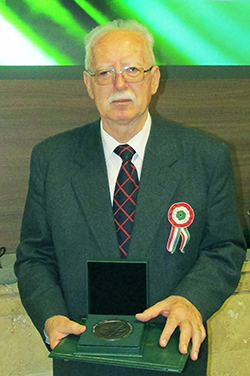
Dr. Sándor Wilhelm
One of the persons awarded was dr. Sándor Wilhelm, author of professional books in ichthyology and retired teacher of biology of the Sándor Petőfi Theoretical Lyceum, Săcueni, Romania, who received the Életfa (Tree of Life) Bronze Commemorative Plaquette ont he occasion of his 70th birthday. The award recognized the teaching and research work of Sándor Wilhelm, his professional books in Hungarian and Romanian language, his contribution to the preservation of the cultural and ethnographic values of the Partium region and his role in the establishment of the fisheries and hunting museum of Săcueni.
Péter Lengyel
Citation: Lengyel P. (2015): Wilhelm Sándor kitüntetése. Halászat 108/2: 14.
On 23rd April 2015 a celebration was organized on the occasion of the Earth Day in the Ministry of Agriculture where 35 persons and/or organizations were decorated by the minister of agriculture Dr. Sándor Fazekas. In his inaugural speech the minister called attention to the fact that all favourized persons and organizations have done value-saving, value-protecting and value-enhancing works in the last years. It is a pleasure to make known that the secretary of our Society was among the recipients.

Dr. László Antal
According to the official motivation Dr. László Antal assistant professor in the Department of Hydrobiology of the Faculty of Science and Technology of the University of Debrecen and the secretary of the Hungarian Ichthyological Society earned his decoration for his outstanding work in better cognition of the Hungarian fish-fauna, in education of young researchers, in protection of autochthonous populations in our natural waters as well as for his educational activities for the general public.
We congratulate on the decoration and wish successful work also in the future.
Ákos Harka
Citation: Harka Á. (2015): Antal László: Pro Natura Emlékplakett. Halászat 108/2: 15.
Following closely the spreading route of the Amur sleeper – revealed on Hungarian territory in 1997 – it was verified repeatedly that the species is able gaining ground quickly down the river but it is spreading very slowly upstream.
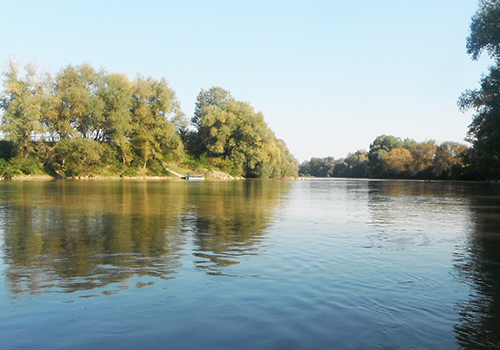
The Amur sleeper appeared also in the Hungarian section of the Szamos (Photo: Ákos Harka)
Whilst the species – which got into Hungary through the Bodrog river – appeared along the whole Tisza river below Tokaj as far has not found in the stretch above Tokaj (to the places of occurrence in the Bereg region it has got through the canals in connection with the Latorica). Because of this it was slightly surprising when an adult specimen was found in our net int he Hungarian section of the Szamos/Somes on 1st October 2014. Nevertheless it was not a great surprise as he spot was close to the outlet of the Tunyogmatolcsi-Holt-Szamos backwater (geo-coordinates: N47°59´ 02.84” E22°27´ 10.02”) and in the stagnant waters managed for fisheries (like this Holt-Szamos) many times the Amur sleeper – getting in with transports of fish – forms significant population. Probably the specimen caught by us also had got to the main course of the river from the backwater.
Zsolt Szepesi, Ákos Harka
Citation: Szepesi Zs., Harka Á. (2015): Amurgéb (Perccottus glenii) a Szamosban. Halászat 108/2: 15.
On 7th August 2014 we were investigating the fishfauna of two watercourses in the catchment area of the Hungarian section of the Mura: the Kerka and its tributary, the Lendva creek. The survey carried out by electrofishing research equipment with the collaboration of colleagues Máté Magyari and Ágnes Papp proved to be particularly successful int he second locality, in the section of the Lendva near the mouth. Over and above the representatives of the common small species we caught nase (Chondrostoma nasus), barbel (Barbus barbus), silver bream (Vimba vimba), chub (Squalius cephalus) and burbot (Lota lota) in large numbers but real surprise was the presence of an endemic species of the Danube basin, the Danube roach.

Danube roach from the Lendva (Photo: Csaba Megyer)
The Danube roach (Rutilus virgo earlier Rutilus pigus virgo) , in Hungary under protection with natural value of 10,000 HUF, is one of the nominating species of the Mura-region Natura 2000 area but in the last years we had information on this species only from fishermen and anglers. The 19 cm long specimen was caught about 200 meters from the mouth near Muraszemenye from the Lendva section with paved banks, gravel bottom and a water depth of 90 cm (geo-coordinates: N 46°28’36.29”, E 16°35’30.26”).
Csaba Megyer
Citation: Megyer Cs. (2015): Leánykoncér (Rutilus virgo) a Lendva patakban. Halászat 108/1: 14.
As the result of our fish faunistic investigation conducted on Keleti-Gyöngyös canal, an Amur sleeper specimen occurred in 29. September 2014. The locality can be found to the south-west from Szigetvár, (coordinates: N45.98632 E17.73075), and belongs to the drainage system of River Drava. Since as fishponds are localized on the upstream sections of the canal, accidental introduction of amur sleeper is supposed by an uncontrolled fish transport from an already invaded area.
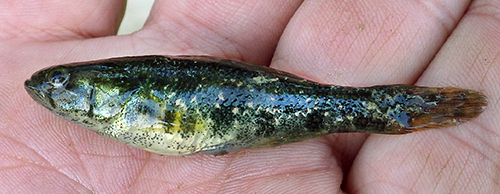
Amur sleeper from the Gyöngyös canal (Photo: Árpád Ferincz)
Péter Takács, István Czeglédi, Árpád Ferincz
| Citation: Takács P., Czeglédi I., Ferincz Á. (2015): Amurgéb (Perccottus glenii) a Dráva vízgyűjtőjéről. Halászat 108/1: 15. | |
The tubenose goby - which was first observed in 1873 in the River Danube near Buda - was caught in the lower section of the River Tisza in Hungary for the first time in 1957. From that time on the spontaneous spread of the species seems to be continuous. The fish prefers the slow flowing parts of the river, the rooty littoral zone but individuals can be found occasionally in channels with dense macrovegetation as well. Ákos Harka and Zsolt Szepesi reported the first individuals from the estuarine region of the River Sajó in 2004. Until 2012 the fish moved upstream about 65 kilometres and reached the village of Sajókeresztúr.
Also in 2012 a fish fauna survey was carried out on behalf of the BioAqua Pro Ltd. and we found this species 20 kilometres further upstream than Harka and Szepesi, near the village of Múcsony (N48° 14' 46,07", E20° 40' 54,70"). Additional localities where the fish was caught by us in the River Sajó in 2013 and in 2014 are near to Tiszaújváros, Kesznyéten, Sajóörös, Girincs, Sajóhidvég, Sajólád, Alsózsolca, Miskolc and Sajóecseg. The appearance of the tubenose goby was expected in the River Bódva as well considering the fact that the estuary of the river is downstream from Múcsony. Our assumption was proved in 2013 when two adults and five yearlings were found in the headwater of the dam at the waterworks of Borsodszirák (near Sajószentpéter) (N48° 14' 54,10", E20° 44' 56,04"). So far the spread of the tubenose goby seems to be really uninterrupted in the water system of the River Sajó.

Habitat of the tubenose goby in the dammed section of the Bódva (Photo: Roland Csipkés)
Our research was supported by the Hungary-Slovakia Cross-border Cooperation Program 2007-2013, the data are available from the projects of “The nature conservation survey of the wetland habitats and watercourses of the River Sajó” (HUSK/1101/221/0063) and “The nature conservational survey of the River Hernád and its tributaries according to the regulation of the Nature Conservational directive of the European Community as well as in accordance with the aim of the River Basin Management Plan” (HUSK/1101/221/0004).
Roland Csipkés, Lajos Szatmári, Ádám Izsó, László Polyák
Citation: Csipkés R., Szatmári L., Izsó Á., Polyák L. (2015): Tarka géb (Proterorhinus semilunaris) a Bódvában. Halászat 108/1: 15.
News 2013
News 2012
News 2011



| Jan | |
12| 2026 | |

Mozilla Firefox
Certified resolution:

1280*xxxx